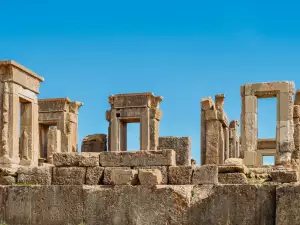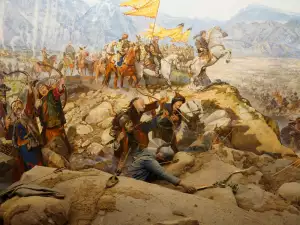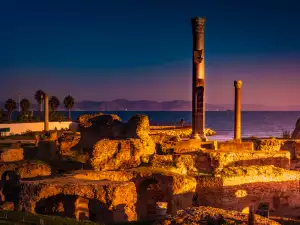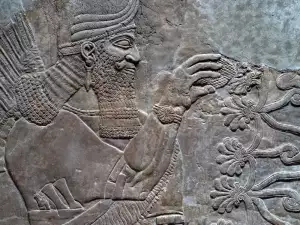The theocratic Arab-Muslim state, created as a result of the Arab conquests in the 7th-9th centuries and ruled by caliphs, is called the Arab Caliphate in the historical chronicles.
There are a number of prerequisites for its creation, which also contribute to the development of the huge empire that the Arab state became in the following centuries.
The Arab Tribes Before the Caliphate
Arabian tribes inhabited the great Arabian Peninsula, extending over 3 million square kilometers of land. The land was primarily dry steppes, deserts and semi-deserts and this affected the lives of the people who lived among this nature.
In the deserts there were oases converted into centers of active life. There were other areas with favorable conditions for the development of agriculture and animal husbandry. Agricultural crops were grown there. This was the area of the Yemen province with large water reserves. Craft production began there, trade also developed.
Most of the peninsula, however, was arid deserts and semi-deserts inhabited by nomads engaged in cattle breeding. They also subsisted by raiding caravans carrying goods across the Arabian Peninsula, which proved to be an important hub as the world's trade routes connecting East Africa and India and Asia Minor passed through it.
Ethnically, the Arabs were divided into North Arabian and South Arabian tribes. On the eve of the unification of all Arabs in one state, the northern tribes still led a nomad life.
Before the unification, the individual tribes were torn by strife and contradictions. The unification was dictated by 2 main reasons, one related to the interests of the nascent aristocracy and the other to the struggle to defend the independence of the Arab community against foreign conquerors.
Establishment of the Arab Caliphate

The processes of unification began in Mecca, Medina and Taif, which were centers of craft and commercial activity. Muhammad ibn Abdallah played a decisive role for the unification. In the year 610, already almost 40 years old, he preached a new religion called Islam. He declared himself a prophet of God Allah and preached in his name.
His followers were called Muslims. The inhabitants of Mecca, in which city Muhammad lived, were hostile to him and this forced him to emigrate to Medina in 622. The migration is considered the beginning of the Muslim calendar. In the year 630, the Muslims captured Mecca and this was the beginning of the Arab state.
After the death of Muhammad, the power over the Arabs was in the hands of the caliphs, the first of whom were his companions and were considered the successors of the Prophet Muhammad. They had power over the state and religion. The state union was called the caliphate.
Religiously, Islam prevailed everywhere and became the dominant religion in the caliphate.
Government in the Arab Caliphate
Nearly 30 years after Muhammad 4 caliphs ruled: Abu Bakr, Omar, Uthman and Ali.
Abu Bakr is better known for putting down rebellions in many areas of Arabia and Omar for conquering Syria, Palestine, Egypt and Iran.
The Arabs also defeated the troops of Byzantium, exhausted by the wars with the Persians, who were also subdued by the caliphate.
Under Caliph Othman the Arabs conquered North Africa and reached Carthage. Iran was also completely overrun.
Armenia and Georgia also became vassal territories of the caliphate and that's how the Arabs became neighbors of the Khazars.
In the vast conquered territory, the Arab caliphate maintained tolerance towards foreign religions and the forms of exploitation towards the local population were completely tolerated. Therefore, the population in the conquered territories accepted them without much resistance.
Large masses of Arabs settled in these territories and imposed the Arab way of life. In Iraq and Syria, this process was relatively peaceful, but in Egypt and Transcaucasia, where the local population was at a higher stage of development, the immigrants decreased.
Dynasties in the Arab Caliphate
Omaids
Internal contradictions in the caliphate grew as a result of corruption and therefore Caliph Osman was killed in a rebellion and Ali took his place. However, the governor in Syria - Mu'aviy raised an uprising and declared himself caliph. Since he was descended from the Omay family, the dynasty he founded remained known as the Omaids. They ruled for about 90 years.
The Umayyads conquered lands in North Africa and the Pyrenees. They made an attempt to capture Constantinople as well, but were stopped by the Bulgarian ruler Tervel.
In 732, the Major-dome Charles Martel defeated them at Poitiers and ended their attempts to conquer Europe.
In Asia, however, the Arabs conquered Afghanistan and reached Northwest India. The Caliphate included lands from the Atlantic Ocean to India and China.
In the year 747, an uprising broke out by Abu Muslim, a former slave, who was supported by people dissatisfied with the ruling of the Umayyads from different strata of society. The anti-upra movement was ruled by a new dynasty, that of the Abbasids, descendants of the Prophet Muhammad's uncle.
Ruling of the Abbasid dynasty

The Abbasid dynasty began to rule the caliphate in 750 to 1258.
Economic life under their ruling developed, but a number of territories were lost. Feudal oppression intensified, class inequality deepened and the situation of the poor got worse. This led to the outbreak of a number of uprisings that undermined the foundations of the state.
The Arab caliphate collapsed in the middle of the 11th century when it was invaded by foreign invaders. The Seljuk Turks captured the Caliphate of Baghdad. The actual end came in 1258, when the last caliph Mutaslim was beheaded.
The Arab Cultural Heritage
The culture left behind by the Arabs was extremely rich, complex and contradictory. Although it is called Arab, it was created by different people, who were part of the caliphate.
The cultural centers were Basra, Baghdad, Damascus, Cairo, Cordova and others. The Arabs developed mathematics, physics and invented numbers.
Medicine also received a strong boost thanks to Arab doctors. Avicenna left his name as an eminent physician.
Literary works, philosophical thought have their models in the face of the Arabs. They influenced the European Renaissance.
The Era of the Arab Golden Age
The fifth caliph of the Abysid dynasty, Harun al-Rashid ruled the Baghdad Caliphate from 786 to 809. Under him, the state reached economic and cultural prosperity and the ruler became famous for his justice. This ruler is a character from the tales of Scheherazade.
The caliph founded a library and university in Baghdad and established good relations with Charlemagne. Gifts to the European ruler included expensive fabrics, perfumes, a water clock, an ivory chess set. These were subjects unknown to the Franks, who learned from the achievements of the Arab masters. The believers were given free access to the Holy Sepulcher thanks to the good relations between the two rulers.












